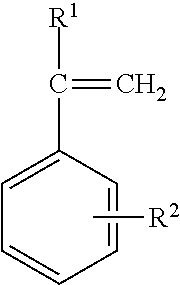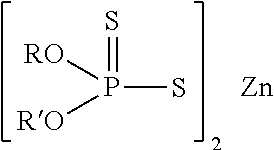Olefin copolymer VI improvers and lubricant compositions and uses thereof
a technology of olefin copolymer and lubricant composition, which is applied in the direction of lubricant composition, organic chemistry, fuels, etc., can solve the problems of fluids with relatively high hths viscosity, lubricating oil may be exposed to low temperatures, and lubricating oil encounters high shear rate, so as to improve fuel economy in a vehicle
- Summary
- Abstract
- Description
- Claims
- Application Information
AI Technical Summary
Benefits of technology
Problems solved by technology
Method used
Image
Examples
examples
[0076]In the following examples (1-10), an ethylene-propylene copolymer containing 80 mole % ethylene was fed to a twin screw extruder. Monomers and 2,5-dimethyl-2,5-di(t-butylperoxy)-3-hexyne catalyst were metered into the extruder at the wt % shown in Table 3. The processing temperature in the extruder was controlled to between about 180-230° C. The resulting grafted polymer was recovered at the end of the extruder through a die and cooled underwater. The grafted polymers of examples 1-10 were dissolved in a Group II 110 N base oil at 6 wt % polymer in the base oil. The viscosity at 100° C. of the polymer solution was measured by ASTM D445. The molecular weight of the samples was measured by gel permeation technology using polystyrene standards. These results are shown in Table 4.
[0077]
TABLE 3BaseMonomer 1Monomer 2CatalystSamplePolymerMonomer 1Monomer 2wt %wt %wt %180 Mole %C10 / C12 / C14Styrene106.180.24Ethylene-Alpha Olefin2PropyleneC10 / C12 / C14Styrene106.180.48CopolymerAlpha Olefin...
PUM
| Property | Measurement | Unit |
|---|---|---|
| Percent by mass | aaaaa | aaaaa |
| Percent by mass | aaaaa | aaaaa |
| Temperature | aaaaa | aaaaa |
Abstract
Description
Claims
Application Information
 Login to View More
Login to View More - R&D
- Intellectual Property
- Life Sciences
- Materials
- Tech Scout
- Unparalleled Data Quality
- Higher Quality Content
- 60% Fewer Hallucinations
Browse by: Latest US Patents, China's latest patents, Technical Efficacy Thesaurus, Application Domain, Technology Topic, Popular Technical Reports.
© 2025 PatSnap. All rights reserved.Legal|Privacy policy|Modern Slavery Act Transparency Statement|Sitemap|About US| Contact US: help@patsnap.com


